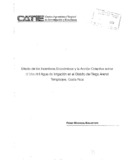| dc.contributor.advisor | Alpízar, Francisco | |
| dc.contributor.author | Madrigal Ballestero, Róger | |
| dc.date.accessioned | 2014-10-17T14:42:00Z | |
| dc.date.available | 2014-10-17T14:42:00Z | |
| dc.date.issued | 2003 | es_ES |
| dc.identifier | 365886 | es_ES |
| dc.identifier.uri | https://repositorio.catie.ac.cr/handle/11554/1470 | |
| dc.description | Tesis (M. Sc) -- CATIE, Turrialba (Costa Rica), 2003 | es_ES |
| dc.description.abstract | Este trabajo busca dos objetivos generales: Primero, realizar un diagnóstico del uso actual del agua de riego en el DRAT y en segundo lugar, determinar el efecto que produce la tarifa de cobro actual y el marco institucional prevaleciente sobre los patrones de uso de agua de riego en el lugar. En relación al primer objetivo, el estudio de eficiencia de retención demuestra que el 31 por ciento del agua aplicada al bloque de parcelas CL-3 de Bagatzí, se pierde en los drenajes, lo cual implica un mal uso del agua porque este volumen no se reutiliza por otros cultivos y podría arrastrar una cantidad importante de sedimentos y agroquímicos hacia las zonas vecinas de protección. Como complemento, se encontró que el arroz es la actividad que genera menos valor por metro cúbico de agua, a pesar que tiene la mayor participación en términos de área dentro del DRAT. Con respecto al segundo objetivo, se demuestra cómo el sistema actual de tarifas provoca inequidad en el cobro entre cultivos. Como alternativa de cobro se presenta dos opciones: una tarifa mixta, compuesta por un componente fijo y uno volumétrico, y por parte, una tarifa diferenciada por cultivo. Estos resultados fortalecen la idea que la formación de organizaciones en el DRAT es un proceso largo y costoso y que recrear las condiciones del Asentamiento Bagatzí en 1993 no se puede lograr en el corto plazo. | es_ES |
| dc.description.abstract | The general objectives of the research were to conduct a diagnostic study of current utilization of irrigation water in the Arenal Tempisque Irrigation District (Distrito de Riego Arenal Tempisque - DRAT), and to determine the effect of present tariffs and institutional framework on water utilization patterns. The diagnostic study conducted on water retention efficiency showed that 31 percent of water irrigating the CL-3 block of plots in Bagatzí was lost through drainage, thus implying a misuse of water resources since these are not re-utilized for other crops, and also because significant loads of sediments and agro-chemicals are likely to be leached to neighboring protection zones. It was also found that rice cultivation generates the least value per cubic meter of utilized water, despite being the crop covering the largest surface area within the DRAT. It was found that the current system of water resource tariffs lead to inequities regarding the charges made for the different crops. Two options are presented as alternative tariff systeMON: 1) a mixed tariff comprised of fixed and volumetric components, and 2) a tariff per crop. | |
| dc.language.iso | es | es_ES |
| dc.publisher | CATIE, Turrialba (Costa Rica) | es_ES |
| dc.subject | WATER USE | |
| dc.subject | IRRIGATION WATER | |
| dc.subject | SOIL WATER RETENTION | |
| dc.subject | DEMAND | |
| dc.subject | COSTS | |
| dc.subject | PRICE FIXING | |
| dc.subject | INCENTIVES | |
| dc.subject | SOCIAL PARTICIPATIONUSO DEL AGUA | |
| dc.subject | AGUA DE RIEGO | |
| dc.subject | RETENCION DE AGUA POR EL SUELO | |
| dc.subject | DEMANDA | |
| dc.subject | COSTOS | |
| dc.subject | FIJACION DE PRECIOS INCENTIVOS | |
| dc.subject | PARTICIPACION SOCIAL | |
| dc.subject | COSTA RICA | |
| dc.title | Efecto de los incentivos económicos y la acción colectiva sobre el uso del agua de irrigación en el Distrito de Riego Arenal Tempisque, Costa Rica | es_ES |
| dc.title.alternative | Effect of economic incentives and collective action on utilization of irrigation water in Arenal Tempisque Irrigation District (DRAT), Costa Rica | es_ES |
| dc.type | Tesis de maestría | es_ES |
| dc.identifier.publication | Turrialba (Costa Rica) | es_ES |


